| Listing 1 - 6 of 6 |
Sort by
|
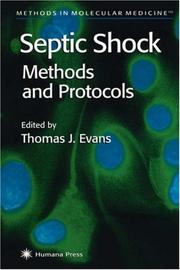
ISBN: 1280830239 9786610830237 1592592163 0896037304 0585355665 Year: 2000 Publisher: Totowa, NJ : Humana Press : Imprint: Humana,
Abstract | Keywords | Export | Availability | Bookmark
 Loading...
Loading...Choose an application
- Reference Manager
- EndNote
- RefWorks (Direct export to RefWorks)
In Septic Shock Methods and Protocols, an interdisciplinary panel of expert investigators describe proven methods for investigating the often deadly mechanisms of septic shock. Drawing on insights from a wide variety of fields-ranging from molecular and cellular biology to the physiological measurement of whole animals-these experienced laboratorians detail the most important techniques for studying sepsis involving endotoxins, toxins derived from gram-positive organisms, cytokines, nitric oxide and other reactive nitrogen intermediates, and the use of primary cell cultures. They also treat a number of significant techniques that are not well described in the literature, including the Limulus endotoxin assay, the bioassay of TNF, the purification of bacterial endotoxin and superantigens, and the culture of primary human cells. Multidisciplinary and state-of-the-art, Septic Shock Methods and Protocols offers both experimental and clinical investigators a gold-standard collection of key methods for illuminating the basic pathophysiological processes that occur following infection. Its readily reproducible methods will allow both newcomers and those with more experience to apply today's powerful techniques successfully in their work.
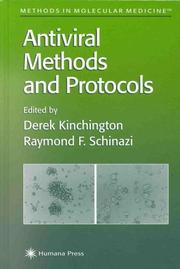
ISBN: 0896035611 1280831367 1592592457 0585235686 Year: 2000 Publisher: Totowa, NJ : Humana Press : Imprint: Humana,
Abstract | Keywords | Export | Availability | Bookmark
 Loading...
Loading...Choose an application
- Reference Manager
- EndNote
- RefWorks (Direct export to RefWorks)
In Antiviral Methods and Protocols, experienced scientists describe-in an easily-followed format-their state-of-the-art techniques for evaluating antiviral compounds. The assays described include systems for investigating drugs used against herpesviruses, hepatitis viruses, human immunodeficiency viruses, human papillomaviruses, and influenza viruses. These well-tested methods range from cellular assays to some of the most up-to-date molecular approaches for identifying compounds that are active against viral enzymes and the development of viral resistance against drugs currently in use. The detailed protocols also discuss possible pitfalls and ways to overcome them. Timely and comprehensive, Antiviral Methods and Protocols offers today's researchers in academia, clinical departments, and the pharmaceutical industry the powerful, reproducible, and novel methods needed to evaluate compounds effective against both acute and chronic infections.
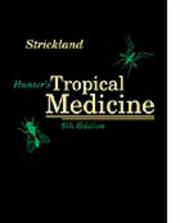
ISBN: 0721662234 9780721662237 Year: 2000 Publisher: Philadelphia Saunders
Abstract | Keywords | Export | Availability | Bookmark
 Loading...
Loading...Choose an application
- Reference Manager
- EndNote
- RefWorks (Direct export to RefWorks)
Tropical Medicine --- Tropical medicine --- Emerging infectious diseases --- Tropical Medicine. --- Medicine, Tropical --- Diseases, Tropical --- Hygiene, Tropical --- Medicine --- Public health, Tropical --- Sanitation, Tropical --- Tropical diseases --- Medical climatology --- Emerging infections --- New infectious diseases --- Re-emerging infectious diseases --- Reemerging infectious diseases --- Communicable diseases
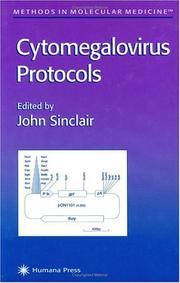
ISBN: 0896037495 0585235678 9786610830442 1280830441 1592592449 Year: 2000 Publisher: Totowa, NJ : Humana Press : Imprint: Humana,
Abstract | Keywords | Export | Availability | Bookmark
 Loading...
Loading...Choose an application
- Reference Manager
- EndNote
- RefWorks (Direct export to RefWorks)
In Cytomegalovirus Protocols (CMV), John Sinclair and a panel of expert investigators present a comprehensive collection of cellular and molecular techniques for the analysis of cytomegalovirus biology and its pathogenetic mechanisms. The methods-all described in step-by-step detail with ready reproducibility in mind-range from basic virus culture to complex molecular analysis of CMV structure and function. Included are methods for CMV detection using both immunological and biological techniques, methods for analyzing fundamental aspects of the CMV infection cycle, and methods for analyzing T cell response to cytomegalovirus infection in the human host. Comprehensive and state-of-the-art, Cytomegalovirus Protocols provides investigators with a powerful collection of the key methods that are illuminating not only the basic biology of this complex and intriguing human herpesvirus, but also its significant role in the pathogenesis of human infectious diseases as well as their emergent therapies.
Cytomegalovirus infections --- Cytomegaloviruses --- Pathology, Cellular. --- Cellular pathology --- Cytopathology --- Pathology --- Cytodiagnosis --- Salivary gland viruses --- Herpesviruses --- CMV infections --- Cytomegalovirus disease --- Herpesvirus diseases --- Emerging infectious diseases. --- Infectious Diseases. --- Emerging infections --- New infectious diseases --- Re-emerging infectious diseases --- Reemerging infectious diseases --- Communicable diseases --- Cytomegalovirus --- Cytomegalovirus Infections --- Genetic Techniques --- Laboratory Manuals --- isolation & purification --- genetics
Book
ISBN: 1281960209 9786611960209 1603274006 1603273999 Year: 2000 Publisher: Totowa, N.J. : Humana Press,
Abstract | Keywords | Export | Availability | Bookmark
 Loading...
Loading...Choose an application
- Reference Manager
- EndNote
- RefWorks (Direct export to RefWorks)
In this second edition of Infectious Diseases and Arthropods, Jerome Goddard summarizes the latest thinking about the biological, entomological, and clinical aspects of the major vector-borne diseases around the world. His book covers mosquito-, tick-, and flea-borne diseases, and a variety of other miscellaneous vector-borne diseases, including Chagas' disease, African sleeping sickness, onchocerciasis, scrub typhus, and louse-borne infections. The author provides for each disease a description of the vector involved, notes on its biology and ecology, distribution maps, and general clinical guidelines for treatment and control. Among the diseases fully discussed are malaria, dengue and yellow fevers, lymphatic filariasis, spotted fevers, ehrlichiosis, lyme disease, tularemia, and plague. Other arthropod-caused or related problems-such as myiasis, imaginary insect or mite infestations, and arthropod stings and bites-are also treated. At a time when vector-borne diseases are spreading ever more widely, Infectious Diseases and Arthropods provides physicians, infectious disease specialists, medical entomologists, and public health officials with an up-to-date, readily accessible, gold-standard reference source.
Arthropod vectors. --- Arboviruses. --- Insects as carriers of disease. --- Medical entomology --- Arthropod-borne viruses --- Arthropoda as carriers of disease --- Medicine. --- Medical microbiology. --- Virology. --- Infectious diseases. --- Tropical medicine. --- Epidemiology. --- Medicine & Public Health. --- Infectious Diseases. --- Medical Microbiology. --- Tropical Medicine. --- Diseases --- Public health --- Diseases, Tropical --- Hygiene, Tropical --- Medicine --- Public health, Tropical --- Sanitation, Tropical --- Tropical diseases --- Medical climatology --- Microbiology --- Clinical sciences --- Medical profession --- Human biology --- Life sciences --- Medical sciences --- Pathology --- Physicians --- Emerging infectious diseases. --- Microbiology. --- Medical virology. --- Medical microbiology --- Virology --- Virus diseases --- Microbial biology --- Biology --- Microorganisms --- Emerging infections --- New infectious diseases --- Re-emerging infectious diseases --- Reemerging infectious diseases --- Communicable diseases
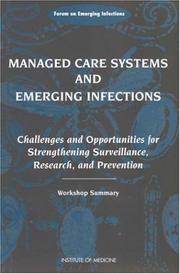
ISBN: 0309068282 9786610185634 1280185635 0309593883 0585259909 9780585259901 9780309068284 9781280185632 6610185638 9780309593885 0309172284 9780309172288 Year: 2000 Publisher: Washington, D.C. National Academy Press
Abstract | Keywords | Export | Availability | Bookmark
 Loading...
Loading...Choose an application
- Reference Manager
- EndNote
- RefWorks (Direct export to RefWorks)
MEDICAL --- Health Care Delivery --- Managed care plans (Medical care) --- Emerging infectious diseases --- Insurance, Health --- Drug Resistance --- Patient Care Management --- Health Care Quality, Access, and Evaluation --- Public Health Practice --- Microbiological Phenomena --- Health Services Administration --- Insurance --- Phenomena and Processes --- Pharmacological Phenomena --- Public Health --- Health Care --- Environment and Public Health --- Financing, Organized --- Physiological Phenomena --- Economics --- Health Care Economics and Organizations --- Delivery of Health Care --- Drug Resistance, Microbial --- Communicable Disease Control --- Managed Care Programs --- Health & Biological Sciences --- Medical Care Plans --- Emerging infectious diseases. --- Managed care programs (Medical care) --- Managed care systems (Medical care) --- Managed health care --- Plans, Managed care (Medical care) --- Programs, Managed care (Medical care) --- Systems, Managed care (Medical care) --- Emerging infections --- New infectious diseases --- Re-emerging infectious diseases --- Reemerging infectious diseases --- Health insurance --- Medical care --- Communicable diseases
| Listing 1 - 6 of 6 |
Sort by
|

 Search
Search Feedback
Feedback About UniCat
About UniCat  Help
Help News
News